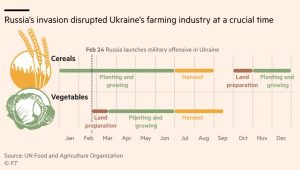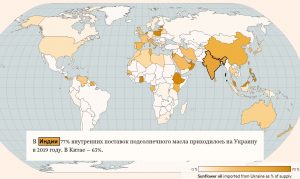Two months of war against Ukraine, which exported 30% of the world’s sunflower oil reserves and grew 4% of its wheat, had a significant impact on international grain and oil markets.
During the war, agricultural land turned into a battlefield, and Ukraine’s road and port infrastructure suffers from attacks by russian missiles and bombs, the country’s food supply chain has stopped, analysts wrote Financial times.
A short excerpt from the material on what leads to the deliberate bombardment of Ukrainian land, equipment, food storage facilities by the russian military, blocking of logistical opportunities for exports is published in a modern business publication. The Page.
According to Minister of Agrarian Policy Mykola Solsky, the war has caused a global supply disruption. Ukraine accounts for 8% of world wheat exports, 13% of corn supplies and more than a third of sunflower oil trade. The country typically exports 40 to 50 million tons of grain annually, but russia’s invasion has resulted in a quarter of March’s exports in March.
War and famine. Food as a weapon
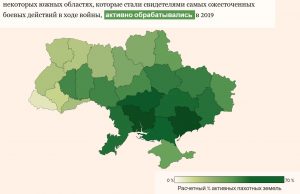
By bombing agricultural lands, the russians “want to repeat the famine not only in Ukraine but also to cause famine in the world.” Infographics: Financial Times.
.
The war led to rising food prices around the world. Bread has risen in price in North Africa, and vegetable oil has risen in price in South Asia. Buyers of Ukrainian and russian grain and agricultural products are looking for alternative sources in international markets, bumping into even higher prices.
By striking at Ukraine’s entire agricultural economy, destroying fields, farms, warehouses, roads, bridges and ports, Russia aims to deprive Ukraine of a large source of income, said Caitlin Walsh, director of the Center for Strategic and International Studies in Global Food Security.
.
Ukraine’s leaders have also accused russia of using food as a military weapon. This statement resonated with the historical experience of Ukraine, which lost millions of people to the famine caused by the Soviet Union in the 1930s. During russia’s attacks on some Ukrainian cities, most notably Mariupol, the city was deliberately brought to a humanitarian catastrophe, when people were short of food due to russians blocking the delivery of basic necessities.
Lyudmila Denisova, Ukraine’s human rights ombudsman, recently said that russians “want to repeat the famine not only in Ukraine but also in the world.”
moscow has in fact reaffirmed its readiness to use food as a strategic tool at the international level. russia is the world’s largest exporter of wheat. And Deputy Chairman of the Security Council dmitry medvedev, who previously called food “silent weapons”, now says that russia will not export agricultural products to “our enemies.”
Goods grown in Ukraine account for a significant share of world agricultural production. The country has 30% of the world’s sunflower oil reserves and grows 4% of the world’s wheat.
How to feed the world. The shock of the food system during the war
Ukraine’s problems with exports of goods are particularly acute in Africa and the Middle East, where most of the country’s wheat goes.
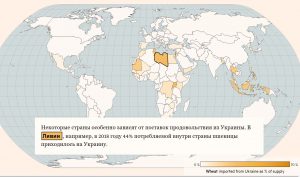
Ukraine accounts for 80% of Lebanon’s imports. It is a key supplier to Somalia, Syria and Libya. Infographics: Financial Times
.
Ukraine accounts for 80% of Lebanon’s imports. It is a key supplier to countries such as Somalia, Syria and Libya. russia also supplies more than 60% of wheat to Turkey. In March, food inflation in Turkey jumped to 70%.
Egypt buys almost two-thirds of its wheat from international markets, making it the world’s largest grain importer. It depends on russia and Ukraine for more than 80% of imported wheat. Cairo turned to the IMF for support last month after the war sparked a sharp rise in wheat, oil and fuel prices..
But the crisis will not only affect countries that buy directly from the two countries. World trade was built in anticipation of uninterrupted supply flows, and the impact of the war affected international grain and oil markets.
Russia is blocking the flow of fuel to Ukraine and the export of goods due to naval blockades. Prior to the invasion, 90% of Ukraine’s agricultural exports were exported by sea. Most of these goods are stuck in the country and cannot be exported. For example, about 15 million tons, about 40% of the corn crop remains in silos, according to Michael Magdovitz, an agricultural analyst at Rabobank.
Due to the port blockade, Ukrainian farmers who used to send wheat and sunflowers by sea to Egypt and Turkey will now have to look for other customers.
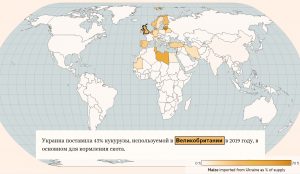
Due to the blockade of ports, 15 million tons (40% of the harvest) of corn remains in silos and cannot be exported. Infographics: Financial Times
.
Export by land is not an easy alternative. Ukraine lacks drivers to transport trucks to the EU, as martial law has been in place for the second month and most conscripts are barred from leaving the country. “Because of the lack of drivers, we don’t have a lot of sunflower oil in [foreign] supermarkets,” says Khakirov of Delta.
The food crisis could continue even after the war, until 2023, if farmers fail to purchase the necessary resources, such as seeds and fertilizers, for the sowing season later this year. Farmers’ existing stockpiles will be depleted by then, and their inability to export means they are running out of money, says Gael Healy, Syngenta’s regional director for Europe, Africa and the Middle East.According to him, the company managed to accept grain, which is now stuck in Ukraine, as payment for seeds, despite the fact that it is not subject to insurance.









